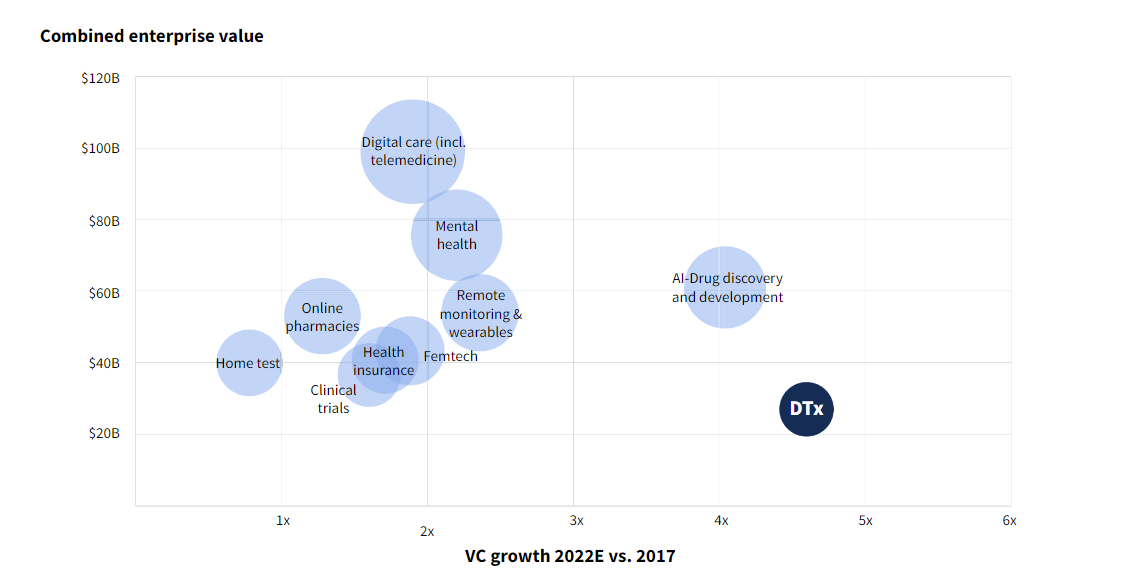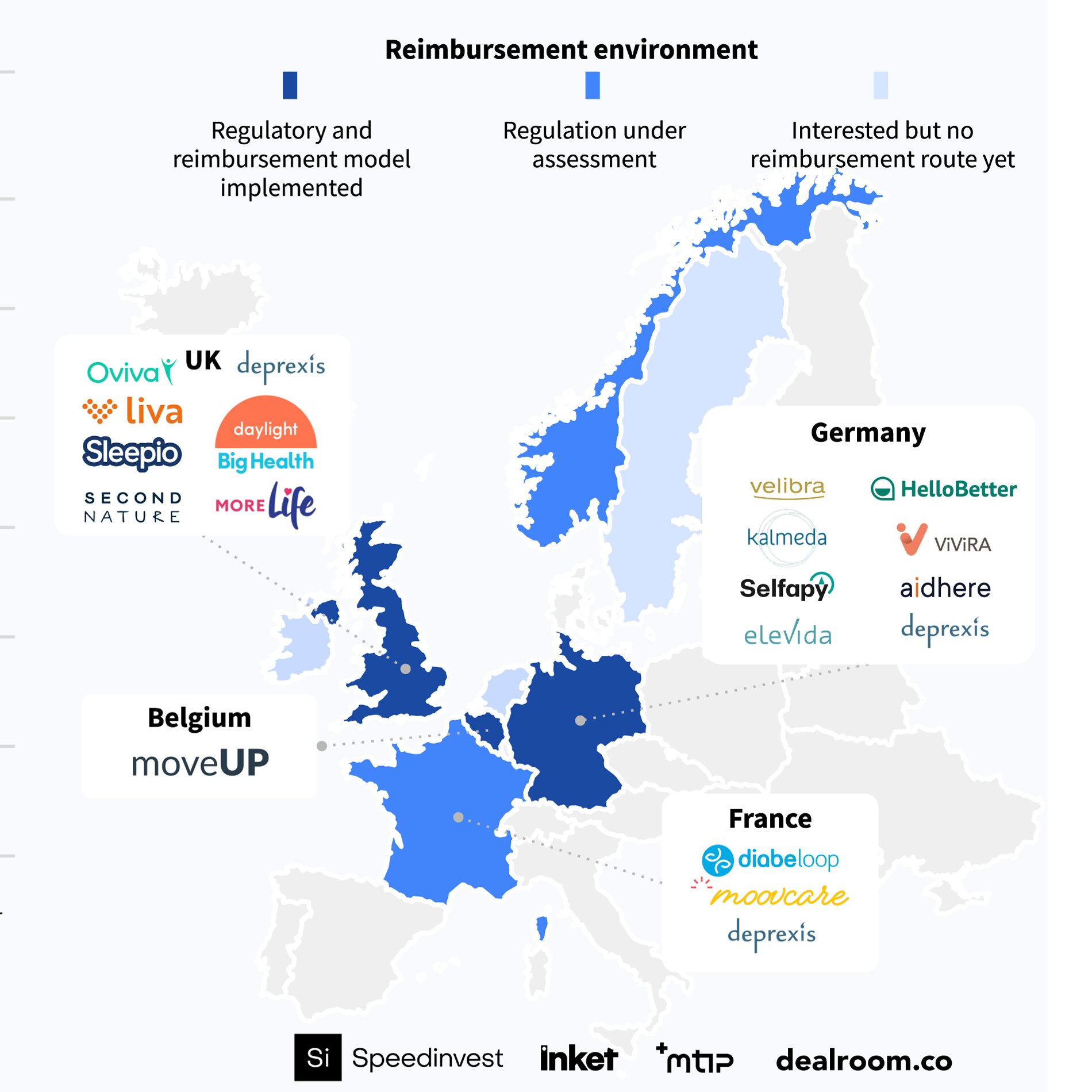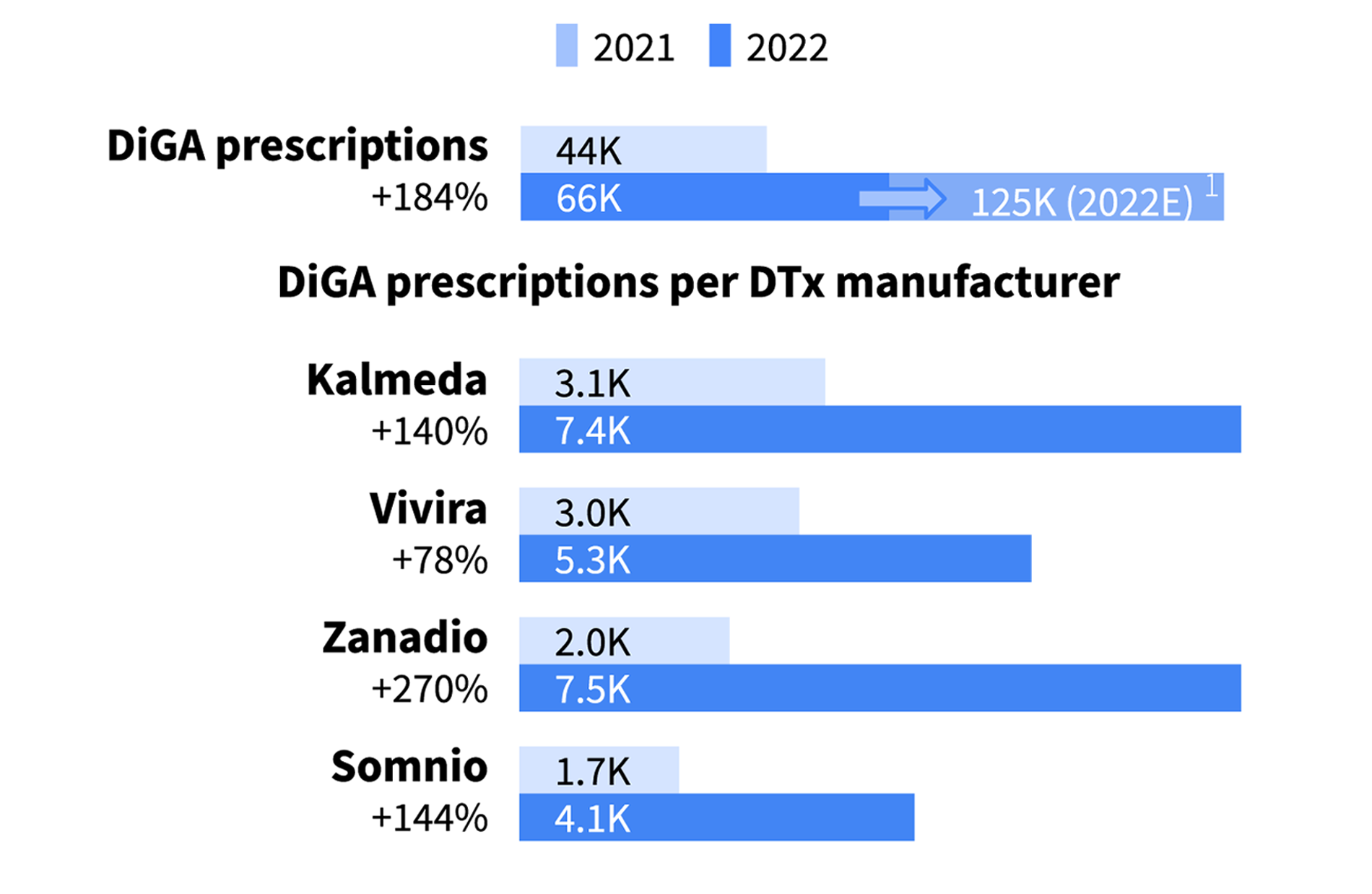Digital Therapeutics (DTx) is a young healthtech segment that is gradually finding its place in the healthcare ecosystem with new regulations and reimbursement schemes happening all over Europe. In partnership with Dealroom.co, MTIP, and Inkef, our first healthtech report finds that VC investment in European Digital Therapeutics companies totalled $645 million between 2020 and 2022, representing a 9x growth compared to 2016. Corporate investment in digital therapeutics reached $329 million in 2022 and is on track to surpass 2021 levels.
We breakdown the key takeaways and drivers of the industry below, including the increasing role that Digital Therapeutics and VC investment are playing in the industry. And we dive deep into the numbers and trends in the full report, which you can download here.
Digital therapeutics has been the fastest growing segment in healthtech since 2017
In Europe alone, more than 50 million people suffer from chronic and difficult-to-manage conditions across digestive, musculoskeletal, respiratory systems and more, with a cost burden estimated at EUR 600 billion a year. Due to the shortage of specialized care givers, patients have to contend with a fragmented treatment journey, lack of long-term support, and high out-of-pocket expenses.
This sadly creates dependency on non-specific drug approaches, such as antidepressants or opioids. While digital innovation accelerated in the wake of COVID-19, deaths related to opioid abuse soared in the past two years. There has never been a greater need for digital disruption to reinvent disease management.
With this pain point in mind, investors have started to warm up to the DTx space and pour capital into the sector. Today, DTx companies continue to grow in number and are increasing the pool of diseases that can be managed. In fact, with $1.5 billion invested globally in 2022 compared to $300 million in 2017, DTx is the fastest-growing field in Digital Health. That said, there’s still a huge untapped potential, with relatively high growth in VC funding and low combined enterprise value compared to other healthtech segments.


Clinical evidence of DTx is accelerating, but long-term data is still missing
DTx solutions require robust evidence of safety, efficacy and value to gain both regulatory approval, reimbursement and a “therapeutic” label (in contrast to wellbeing). Prescribers are unlikely to endorse DTx solutions if claims are not justified by rigorous randomized-controlled trials (RCTs) backed with real-world evidence to demonstrate the economic value of their solution.
There have been 394 interventional studies of DTx tools since 2010 and 88 percent were filed in the last five years, during which time the number of DTx trials climbed 4x. As of today, most DTx trials are delivered through apps (42 percent), web-based systems (26 percent), video games/VR (12 percent) and then other approaches, such as text messages and social media. According to the European Heart Journal, the largest segments for clinical trials are mental health (35 percent), chronic diseases (19 percent), addictions (12.5 percent) and insomnia (9 percent). At the moment, ongoing studies are mostly taking place in North America, followed by Europe and China.
However, we currently don’t have enough data on the long-term clinical benefits of DTx. Unlike medical implants and equipment that are widely accepted, DTx apps still need to prove themselves to users over time; gamification, bug fixes, system upgrades, live support, and intuitive UI/UX are all needed to ensure patient use and treatment compliance. Not adjusting the product intelligently runs the risk of deviating from its treatment plan and creating adverse consequences. From the patient perspective, interest in the technology may also wane if outcomes are not immediate, which is challenging for treatments that require long-term use.
In any case, DTx trials are happening now and will very likely continue into the future. This is great news for patients, to receive clinically validated therapies tailored to their needs. If rich clinical evidence is combined with strong reimbursement processes, DTx could lead to blockbuster products for patients.
The route to success is a minefield with significant barriers to reimbursement and adoption
The European Commission is working on a centralized set of frameworks to drive digital transformation in all EU states. The high-level framework relies on regulations already in place, such as GDPR (data protection), MDR (software and devices certifications), or the EU HDS (Health Data Space). Each month, new DTx get approved, acquire paying customers, and become the standard of care. Germany’s Digital Health Apps program (DiGA) is often cited as the model for other countries to fast-track reimbursement following certification. Belgium’s mHealthBELGIUM and a comparable scheme in France are following in DiGA’s footsteps.


But despite all of this progress, the EU has not released a centralized approval process for new DTx entrants and the rapid pace of DTx innovation will hit a wall if regulations can’t modernize at the same rate. A few questions are slowing down regulatory approvals: As digital therapies evolve through AI/ML, should regulators approve a product now, if it will be different in a few months? Will they receive protection forever?
Physicians often have too little evidence of efficacy and ease of use to prescribe DiGAs. The disconnect between primary and in-home care settings also makes tracking how a DTx has worked over time hard. This discourages clinicians from risking an intervention whose efficacy they can’t measure over time. Finally, several tools require changes to processes, especially in data analysis, and this exacerbates constrained healthcare capacity and requires extensive training for staff. But the response from DiGA users (patients and physicians) has been positive and has increased considerably in the last year, which gives us hope!
Tips to manage risks early and raise money from investors in the space
We're sure you've got your pitch nailed down. But VCs are going to interrupt you and throw some questions at you to better understand your product. Here's a breakdown of some questions you should be prepared to answer.
- What is the standard-of-care for patients and how does your product improve treatment prospects?
- What clinical studies do you need to show to build the evidence? What are the endpoints and controls used?
- Do you have any data on user engagement in the short and long term?
- Does the product fit into the workflow of clinicians and reduce their burden?
- How do you protect patient data?
- What is the level of personalisation achieved with your product? Are you building AI/ML tools?
- Does your team combine both clinical and technology expertise?
- Does the country of launch have a regulatory and reimbursement framework in place?
And here are few things to keep in mind early on:
- Focus on the therapeutic areas with the greatest need from the patient and clinician perspective. Are there already effective solutions out there?
- Don’t be scared to try new therapeutic approaches. Currently, 72 percent of FDA-cleared DTx products utilize cognitive-behavioral therapy to treat patients. Therefore, there’s a need for DTx tools that offer a wider range of digital therapies to correctly address patient heterogeneity.
- Have early discussions with regulators and payers about realistic pricing levels and evidence requirements for reimbursement
- Consider gamification and strong UI/UX to keep patients engaged and ensure therapeutic effects.
All in all, DTx represent an exciting therapeutic opportunity, especially for the treatment of patients suffering from chronic diseases. Since they are similar to conventional drugs in terms of research, development and marketing, harmonization of regulatory processes is fundamental for their success. The growing clinical evidence makes it crucial to educate healthcare professionals and patients to adopt new technologies to consolidate the use of DTx in clinical practice.







